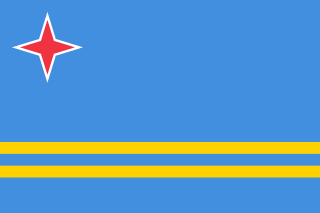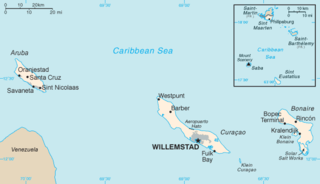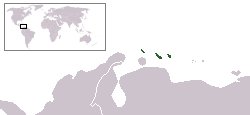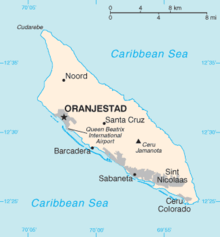
Aruba is an island and a constituent country of the Kingdom of the Netherlands in the mid-south of the Caribbean Sea, about 29 kilometres (18 mi) north of the Venezuelan peninsula of Paraguaná and 80 kilometres (50 mi) northwest of Curaçao. It measures 32 kilometres (20 mi) long from its northwestern to its southeastern end and 10 kilometres (6 mi) across at its widest point. Together with Bonaire and Curaçao, Aruba forms a group referred to as the ABC islands. Collectively, these and the other three Dutch substantial islands in the Caribbean are often called the Dutch Caribbean, of which Aruba has about 1⁄3 of the population.

The Netherlands Antilles was a constituent country of the Kingdom of the Netherlands. The country consisted of several island territories located in the Caribbean Sea. The islands were also informally known as the Dutch Antilles. The country came into being in 1954 as the autonomous successor of the Dutch colony of Curaçao and Dependencies and was dissolved in 2010. The Dutch colony of Surinam, although it was relatively close by on the continent of South America, did not become part of the Netherlands Antilles but became a separate autonomous country in 1954. All the island territories that belonged to the Netherlands Antilles remain part of the kingdom today, although the legal status of each differs. As a group they are still commonly called the Dutch Caribbean, regardless of their legal status. People from this former territory continue to be called Antilleans (Antillianen) in the Netherlands.

The Netherlands Antilles was a constituent country in the Caribbean Sea. It consisted of two island groups, the ABC islands Curaçao, Bonaire and Aruba just north of Venezuela, and the SSS islands east of the Virgin Islands.

The flag of the Netherlands Antilles was white, with a horizontal blue stripe in the center, one-third of the flag's hoist, superimposed on a vertical red stripe of the same width, also centered; six white, five-pointed stars are arranged in a pentagon pattern in the center of the blue band, their points up. It was adopted on 19 November 1959.

Bonaire is an island in the Leeward Antilles in the Caribbean Sea. Its capital is Kralendijk, near the ocean on the lee side of the island. Aruba, Bonaire and Curaçao form the ABC islands, 80 km off the coast of Venezuela. Unlike much of the Caribbean region, the ABC islands lie outside Hurricane Alley. The islands have an arid climate that attracts visitors seeking warm, sunny weather all year round. Bonaire is a popular snorkeling and scuba diving destination because of its multiple shore diving sites and easy access to the island's fringing reefs.

The ABC islands is the physical group of the three westernmost islands of the Leeward Antilles in the Caribbean Sea. These have a shared political history and a status of Dutch underlying ownership, since the Anglo-Dutch Treaty of 1814 ceded them back to the Netherlands, as Curaçao and Dependencies from 1815. They are a short distance north of Falcón State, Venezuela. They are Aruba, Bonaire and Curaçao. Aruba and Curaçao are autonomous, self-governing constituent countries of the Netherlands, while Bonaire is a special municipality of the Netherlands. Property of the Kingdom of the Netherlands, the countries, and municipality, are outside the European Union; citizens have Dutch nationality and the former colonial power benefits from preferential trade, mineral and natural resource rights, particularly offshore.
The music of the former Netherlands Antilles is a mixture of native, African and European elements, and is closely connected with trends from neighboring countries such as Venezuela and Colombia and islands such as Puerto Rico, Cuba, Santo Domingo, Haiti, Martinique, Trinidad, Dominica, and Guadeloupe. The former Netherlands Antilles islands of Curaçao and Aruba are known for their typical waltzes, danzas, mazurkas and a kind of music called tumba, which is named after the conga drums that accompany it.

The Netherlands Antilles national football team was the national team of the former Netherlands Antilles and was controlled by the Nederlands Antilliaanse Voetbal Unie. The NAVU consisted of Curaçao and Bonaire. Aruba split in 1986 and has its own team.
Bonaire Express was an airline based in Bonaire, Netherlands. It was the regional airline for the Netherlands Antilles and also acted as a feeder for DutchCaribbeanExel while under the BonairExel brand and part of the ExelAviation Group and later for KLM for its long-haul services to Europe. Its main bases were Flamingo International Airport (BON), Bonaire, with focus cities in Queen Beatrix International Airport (AUA), Aruba and Hato Airport (CUR), Curaçao.

The Netherlands Antilles was an autonomous Caribbean country within the Kingdom of the Netherlands. It was dissolved on 10 October 2010.
Country Code: +599
International Call Prefix: 00
The Caribbean bioregion is a biogeographic region that includes the islands of the Caribbean Sea and nearby Atlantic islands, which share a fauna, flora and mycobiota distinct from surrounding bioregions.

The Netherlands Antilles participated at the Olympic Games from 1952 until 2008. As a constituent country of the Kingdom of the Netherlands, it supported the Netherlands' boycott of the 1956 Games and also joined the American-led boycott of the 1980 Summer Olympics. The Netherlands Antilles participated in the Winter Olympic Games twice.

The Kingdom of the Netherlands, commonly known as the Netherlands, is a sovereign state and constitutional monarchy with the large majority of its territory in Western Europe and with several small West Indian island territories in the Caribbean.

The following is an alphabetical list of topics related to the former nation of the Netherlands Antilles.
The Curaçao national football team represents Curaçao in International football and is controlled by the Curaçao Football Federation.

The Caribbean Netherlands are the three special municipalities of the Netherlands that are located in the Caribbean Sea. They consist of the islands of Bonaire, Sint Eustatius and Saba, although the term "Caribbean Netherlands" is sometimes used to refer to all of the islands in the Dutch Caribbean. In legislation, the three islands are also known as Bonaire, Sint Eustatius and Saba or the BES islands. The islands are currently classified as public bodies in the Netherlands and as overseas countries and territories of the European Union; thus, EU law does not automatically apply.

The Dutch Caribbean are the territories, colonies, and countries, former and current, of the Dutch Empire and the Kingdom of the Netherlands in the Caribbean Sea. They are in the north and south-west of the long Lesser Antilles archipelago.
An island council was the governing body of an island territory, an administrative level of the Netherlands Antilles until its dissolution.

The Bonaire national football team is the national football team of the Caribbean island of Bonaire, a public body of the Netherlands. It is under the control of the Bonaire Football Federation. It became a member of the CFU and an associate member of CONCACAF on 19 April 2013. after which it became a full CONCACAF member on 10 June 2014 The team can participate in the CONCACAF Gold Cup and Caribbean Cup because of their membership in the confederation and sub-confederation. However, Bonaire is not a member of FIFA and therefore can not compete in the FIFA World Cup or other FIFA events.












